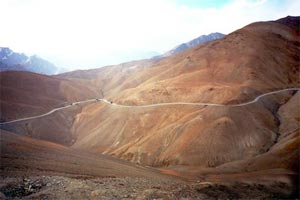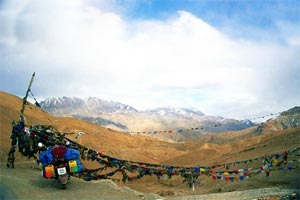|
Sindhu
Darshan
 Topping
up the tank at the fuel station at Kargil we moved on to Mulbekh.
This stretch of 40 kms is one of the best examples of viewing
one religion relinquishing and the other embracing. As we
moved from Kargil, we saw more and more of muslim faces and
small mosques with shining tops. And as we neared Mulbekh
the scenario changed to more and more of mongoloid faces,
Mani walls, chortens, and prayer flags. The hill-top monastery,
about 200 meters above the main road is the piece de resistance
of the Mulbekh town. As we were targeting Leh we never found
time and drive to climb up, but I guess apart from the frescoes
the scenery from the top would be parallel to none as would
be the tearing wind. Taking a snap from the road and turning
the Mani wheel we progressed towards Namika La. One of the
most glaring omissions in our ride after Zanskar valley and
Rangdum Gompa is the 9-metre rock sculpture of Maitreya,
the Future Topping
up the tank at the fuel station at Kargil we moved on to Mulbekh.
This stretch of 40 kms is one of the best examples of viewing
one religion relinquishing and the other embracing. As we
moved from Kargil, we saw more and more of muslim faces and
small mosques with shining tops. And as we neared Mulbekh
the scenario changed to more and more of mongoloid faces,
Mani walls, chortens, and prayer flags. The hill-top monastery,
about 200 meters above the main road is the piece de resistance
of the Mulbekh town. As we were targeting Leh we never found
time and drive to climb up, but I guess apart from the frescoes
the scenery from the top would be parallel to none as would
be the tearing wind. Taking a snap from the road and turning
the Mani wheel we progressed towards Namika La. One of the
most glaring omissions in our ride after Zanskar valley and
Rangdum Gompa is the 9-metre rock sculpture of Maitreya,
the Future
Buddha called ‘Chamba’ in a deep relief a little
further to Mulbekh. We missed it owing to inadequate study.
Mountainscape from Mulbekh onwards was stunning. Barren light
brown  mountains
appeared as if the protruded bellies of giants have been arranged
side by side and over each other. It was quite tempting and
I harbored the wish to poke them. I never knew my wish will
be granted in this tour itself. Namika La didn’t seem
like a high altitude pass and Fotu La, despite being the highest
point on the Leh – Srinagar road, was again not difficult
to climb. Roads were tarred and clean and snowfall was scanty
limited to only upper reaches of the surrounding mountains.
Only adversity felt was the piercing wind which almost froze
us. We hurriedly progressed to chase the fast-dwindling sunlight. mountains
appeared as if the protruded bellies of giants have been arranged
side by side and over each other. It was quite tempting and
I harbored the wish to poke them. I never knew my wish will
be granted in this tour itself. Namika La didn’t seem
like a high altitude pass and Fotu La, despite being the highest
point on the Leh – Srinagar road, was again not difficult
to climb. Roads were tarred and clean and snowfall was scanty
limited to only upper reaches of the surrounding mountains.
Only adversity felt was the piercing wind which almost froze
us. We hurriedly progressed to chase the fast-dwindling sunlight.
After crossing Fotu La a point comes from where we had the
first view of the then spotlit Lamayuru Monastery. Road upto
Lamayuru is spectacular with its sweeping turns and long descents.
At Lamayuru, the road bifurcates into two only to join before
Khaltse. The left one though is longer and desolate as well.
At Khaltse we met Sindhu River – enacting “Sindhu
Darshan”. We rode past the turn to Dah-Hanu valley and
reached PWD resthouse at around 7:30 pm. Khaltse is a very
small township but its strategic location makes it important
because the road going towards Dha-hanu valley connects to
the frontier areas. We relished the food we cooked that night
at PWD rest house but slept over the ‘know-each-other’
bash of young, handsome and pretty but noisy and tipsy medicos
and paramedicos. It was here that we got to hear contemporary
and hit Ladakhi numbers but under the circumstances we disliked
them more.
Top ^
|